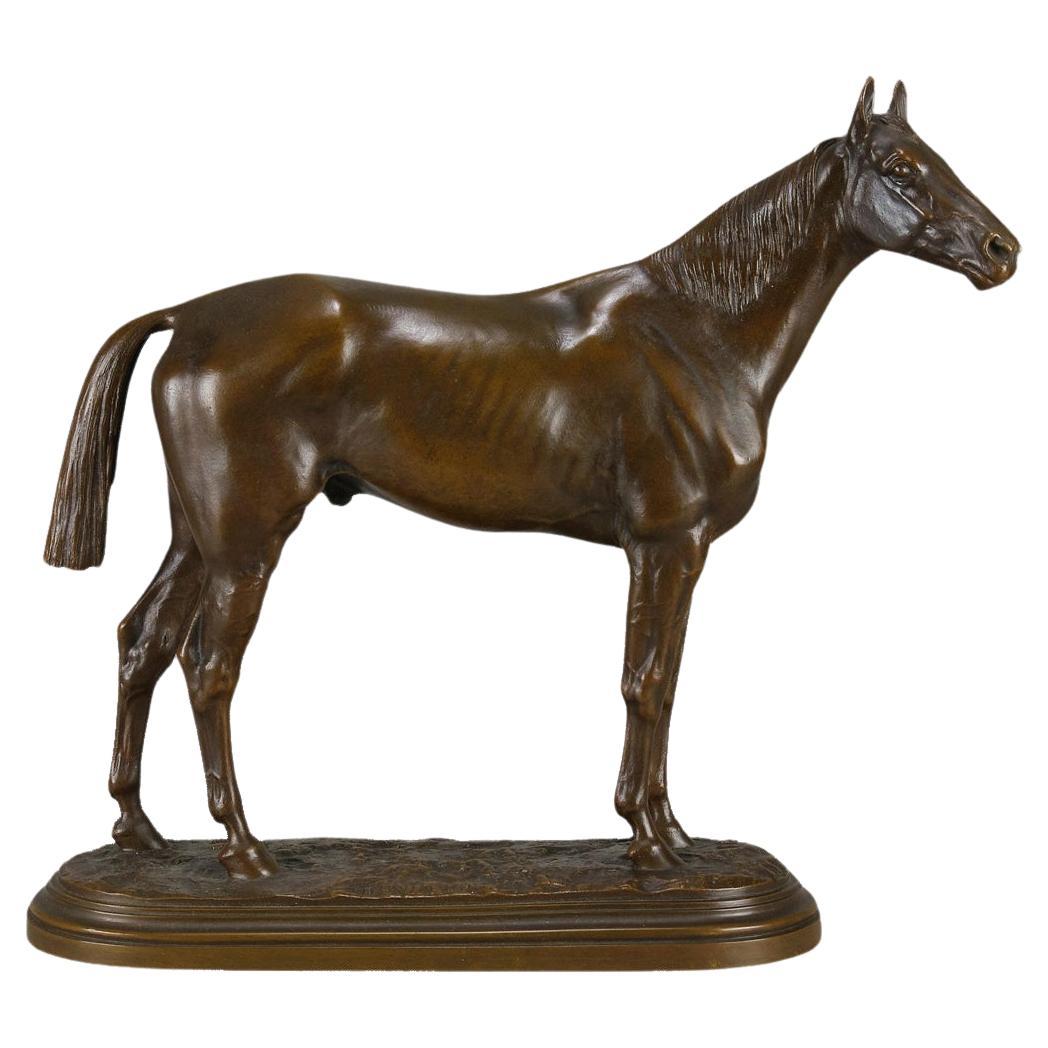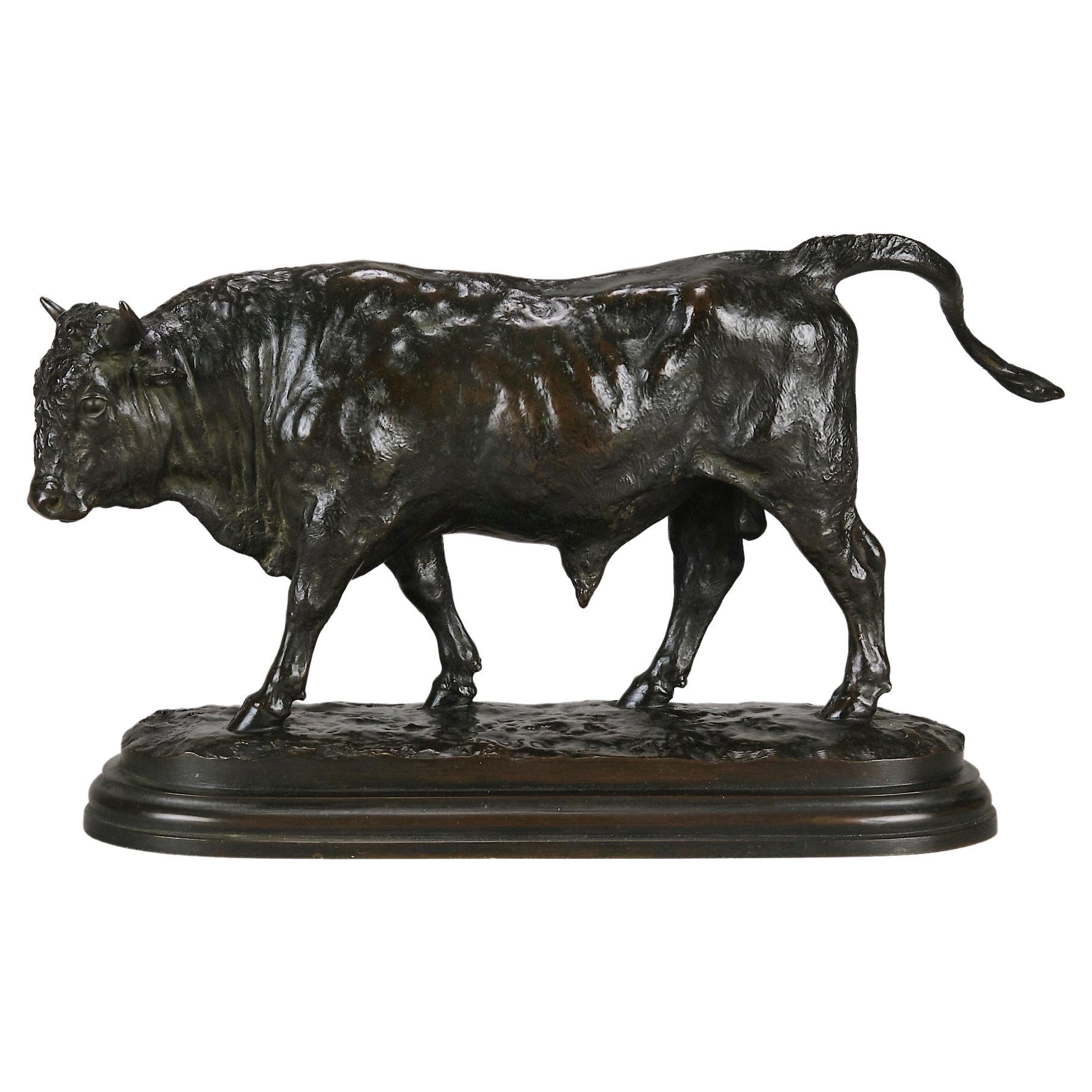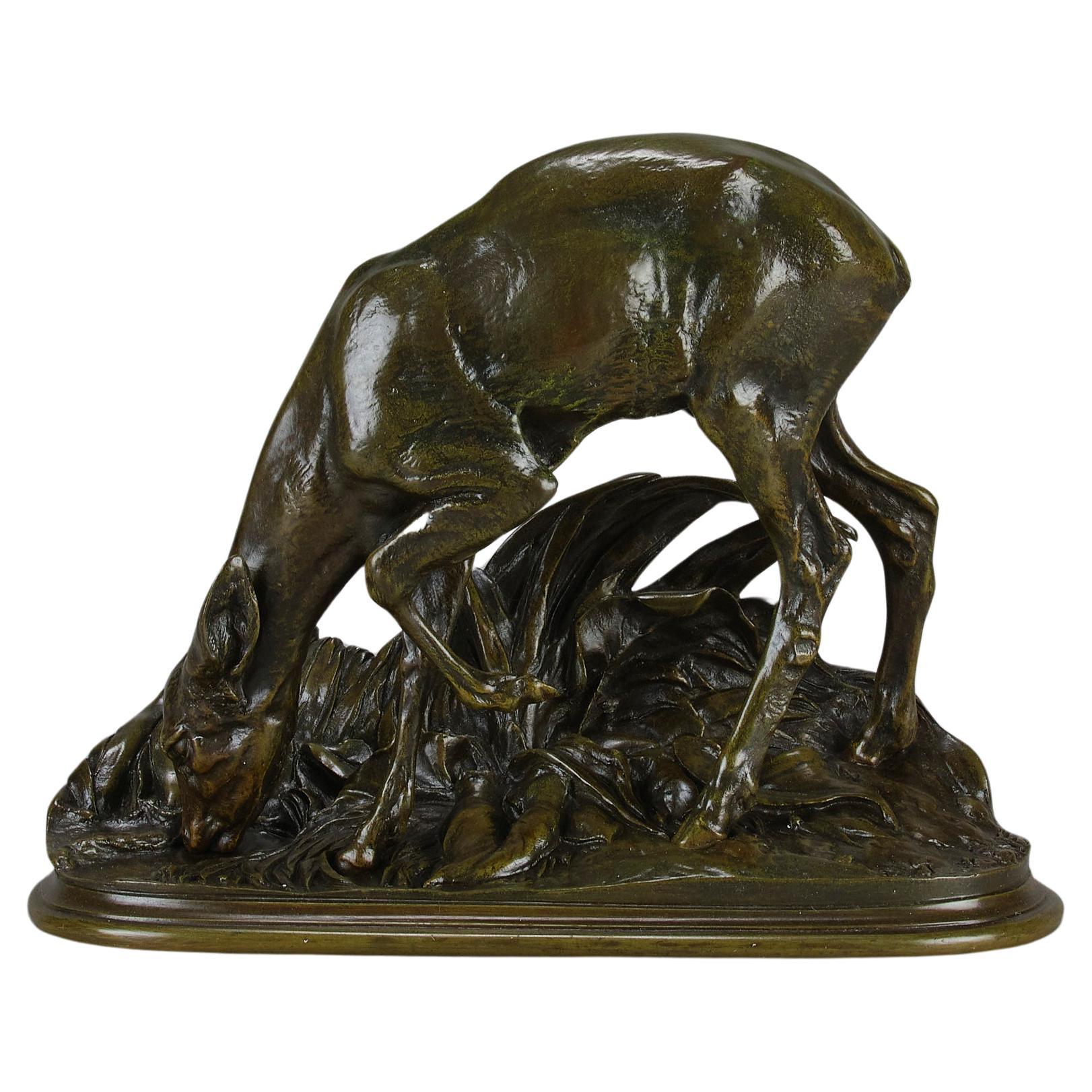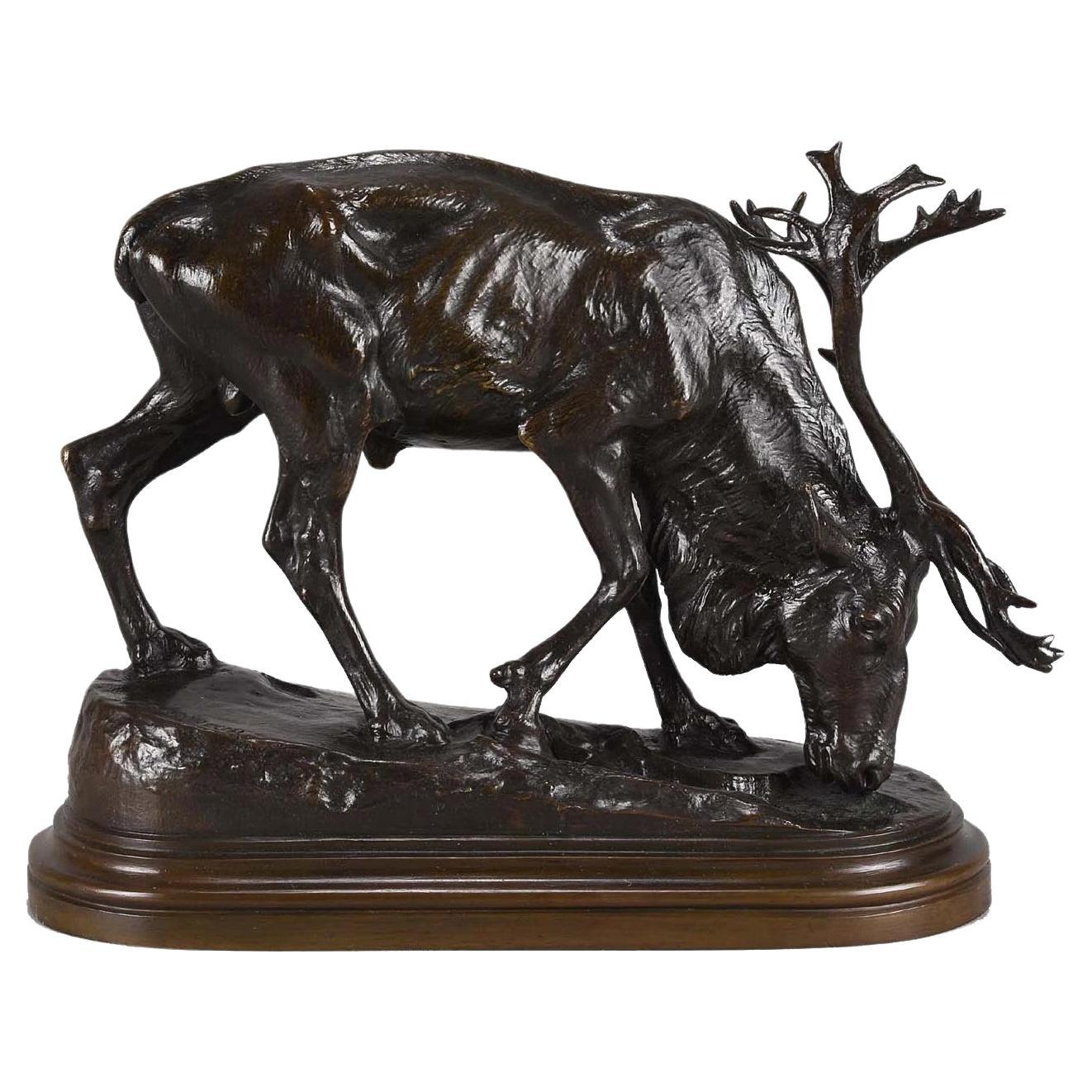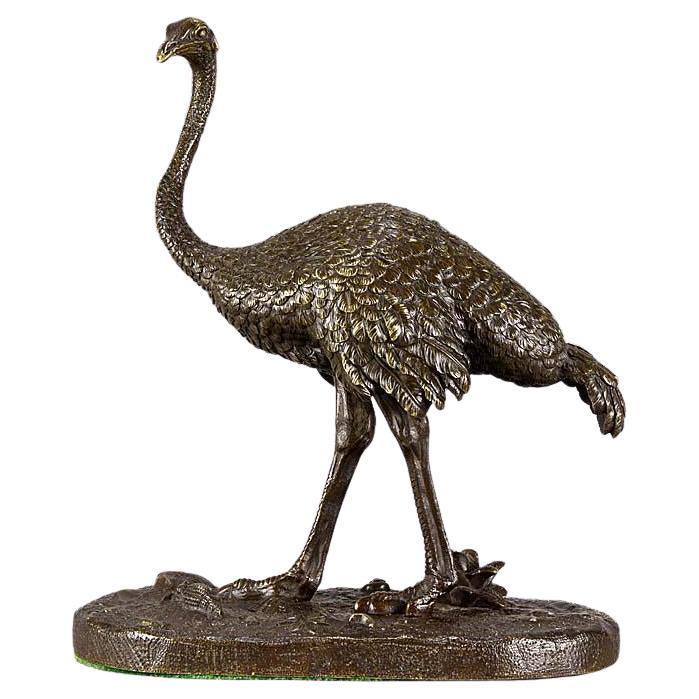Items Similar to Late-19th Century French Animalier Bronze Entitled "Turning Whippet" by L Mayer
Want more images or videos?
Request additional images or videos from the seller
1 of 11
Late-19th Century French Animalier Bronze Entitled "Turning Whippet" by L Mayer
About the Item
Delightful late19th century French Animaliers bronze study of a turning whippet looking around in an attitude to play, with rich brown colour and fine hand chased surface detail. Signed L Mayer and raised on an oval rouge griotte marble plinth.
Additional information
Height: 17 cm
Width: 22 cm
Condition: Excellent Original Condition
Circa: 1880
Materials: Bronze
About
Animaliers sculpture
Although many earlier examples can be found, animalier sculpture became more popular, and reputable, in early 19th century Paris with the works of Antoine-Louis Barye (1795–1875) for whom the term was coined and who became the ‘Father of the Animaliers School’ and Pierre Jules Mêne considered the finest realist sculptor of the era. By the mid-century, a taste for animal subjects was very widespread among all sections of society.
- Creator:Louis Mayer (Artist)
- Dimensions:Height: 6.7 in (17 cm)Width: 8.67 in (22 cm)Depth: 0 in (0.01 mm)
- Style:Art Nouveau (Of the Period)
- Materials and Techniques:
- Place of Origin:
- Period:
- Date of Manufacture:1880
- Condition:Wear consistent with age and use. Excellent. Excellent Original Condition Please note that our items are genuine antiques with considerable age. It is therefore normal that they will show some signs of wear and handling to the surface.
- Seller Location:London, GB
- Reference Number:
About the Seller
5.0
Gold Seller
These expertly vetted sellers are highly rated and consistently exceed customer expectations.
Established in 1936
1stDibs seller since 2017
63 sales on 1stDibs
Typical response time: <1 hour
- ShippingRetrieving quote...Ships From: London, United Kingdom
- Return PolicyA return for this item may be initiated within 10 days of delivery.
More From This SellerView All
- Late 19th Century Animalier Bronze entitled "Cheval Debout" by Isidore BonheurBy Isidore Jules BonheurLocated in London, GBMagnificent late 19th Century French Animalier bronze study of a standing thoroughbred with rich brown patina and excellent crisp surface detail, raised on a stepped integral base, s...Category
Antique Late 19th Century French Art Nouveau Animal Sculptures
MaterialsBronze
- Late 19th Century Animalier Bronze entitled "Hound Family" by Alfred JacquementLocated in London, GBA charming late 19th Century French animalier bronze group of a family of hounds. The bronze of three seated dogs including a mother, father and pup exhibiting excellent rich brown p...Category
Antique Late 19th Century French Art Nouveau Animal Sculptures
MaterialsBronze
- 19th Century Animalier French Bronze Entitled "Taureau Debout" by Rosa BonheurBy Rosa BonheurLocated in London, GB"Taureau Debout" by Rosa Bonheur. An excellent late 19th Century French animalier bronze study of a standing bull with fine hand chased surface that accentuates the muscle definition of the subject, signed Rosa B. ADDITIONAL INFORMATION Measures: Width: 32 cm Height: 18 cm Depth: 11cm Condition: Excellent Original Condition Circa: 1870 Materials: Bronze Book reference: Animals in Bronze by Christopher Payne Page no. 174 DESCRIPTION Bonheur, Rosa (1822-1899) The most popular artist of nineteenth-century France, Rosa Bonheur was also one of the first renowned painters of animals and the first woman awarded the Grand Cross by the French Legion of Honor. A professional artist with a successful career, Bonheur lived in two consecutive committed relationships with women. Born on March 16, 1822 in Bordeaux, Marie Rosalie Bonheur was the oldest of the four children of Raimond Oscar Bonheur (1796-1849) and Sophie Marquis. Bonheur's father was an art teacher who came from a poor family, while her mother, a musician, had descended from a middle-class family and had been her husband's art student. Bonheur's father, who taught drawing and landscape painting, was an ardent member of the utopian Saint Simeon society. The group held idealistic beliefs about the reform of work, property, marriage, and the role of women in society. Most importantly, for the artist's future, the Saint Simeons questioned traditional gender norms and firmly believed in the equality of women. While teaching artistic techniques to his oldest daughter, Raimond Bonheur also encouraged her independence and taught her to consider art as a career. In 1828 Raimond Bonheur joined the Saint Simeons at their retreat outside Paris. Sophie and the children joined him in Paris the following year. Four years later, however, Raimond abandoned his family to live in isolation with his fellow Saint Simeons. Sophie Bonheur died in 1833 at the age of thirty-six. Rosa was only eleven years old when her mother died, but she was aware of the heavy price her mother paid for married life with a man who was more dedicated to his own ideals than to meeting his family's needs. Rosa also saw that her mother's marriage led to poverty and her death from exhaustion. After her mother's death, Bonheur was taken in by the Micas family who resided nearby. Mme Micas and Bonheur's mother had been friends. When Mme Bonheur died, the Micas family paid Raimond Bonheur's debts and cared for Rosa. Their daughther, Nathalie, who would later become an amateur inventor and unschooled veterinarian, and Rosa became enamored with each other. When Rosa Bonheur began her career as a professional artist, she had already been trained by her father who had allowed her to study in all male classes. Rosa also learned by sketching masterworks at the Louvre from the age of fourteen, and later, by studying with Léon Cogniet. From the very beginning, Bonheur's favorite subject was animals. She learned their anatomy completely by dissecting them in local slaughterhouses. She also visited the horse market two times a week. Study of animals by direct observation led to the formation of the realist style in which Bonheur worked. It was for such work that Bonheur obtained written permission from the French government to wear men's slacks. Her working attire also consisted of a loose smock and heavy boots that protected her feet from the dangerous environment in which she painted. The style of dress that the artist adopted for work and home may well have been influenced by her father's attire, which was based on St. Simeonian clothing experiments. Bonheur also cropped her hair, perhaps to facilitate her work. She did, however, always wear dresses for social occasions because she knew that appropriate dress would further her career. Bonheur earned a successful living as a painter of animals. She exhibited at the annual Paris Salon regularly from the age of nineteen in 1841 through 1853, when she was thirty-one. She won the salon's gold medal at the age of twenty-six in 1848 and was commissioned by the French government to paint Plowing on the Nivernais in 1849. In the same year Bonheur and her sister Juliette became directors of l'École gratuite de dessin pour les jeunes filles, a post their father had once held. Bonheur completed her most renowned work, The Horse Fair, in 1855. The successful representation of percherons (a breed native to Normandy) was purchased by Ernest Gambart, a London art dealer whose gallery specialized in work by French artists. He exhibited The Horse Fair in London where Bonheur visited with Nathalie. Queen Victoria requested a private viewing of the painting at Windsor Castle. It would later be purchased in 1887 by Cornelius Vanderbilt and donated to the new Metropolitan Museum of Art in New York City. Bonheur's trip to England allowed her to meet Charles Eastlake, then President of the Royal Academy, John Ruskin, the English writer and critic, and Edwin Landseer, the British animalier. She also toured the English and Scottish countrysides and executed some paintings based on her observations of new breeds of animals found there. Gambart made engravings of Bonheur's work, including The Horse Fair, and sold them in England, Europe, and the United States. Bonheur became one of the most renowned painters of the time. Little girls, such as Anna Klumpke in the United States, even had dolls in her likeness, much as American girls played with Shirley Temple dolls...Category
Antique 19th Century French Art Nouveau Animal Sculptures
MaterialsBronze
- Late 19th Century Animalier Bronze entitled "Biche Buvant" by Pierre Jules MêneBy Pierre Jules MêneLocated in London, GBA very rare mid 19th Century Animalier bronze study of a doe drinking by the side of a lake, the bronze with fabulous rich brown patina and very fine hand chased surface detail, rais...Category
Antique Late 19th Century French Art Nouveau Animal Sculptures
MaterialsBronze
- 19th Century Animalier Bronze Sculpture Entitled "Reindeer" by Isidore BonheurBy Isidore Jules BonheurLocated in London, GBExcellent late 19th century animalier bronze study of a feeding reindeer with rich brown colour and very fine hand chased and etched surface detail, raised on a stepped naturalistic base, stamped with Peyrol Foundry mark and signed Isidore Bonheur Additional information Height: 16 cm Width: 22 cm Condition: Excellent Original Condition Foundry: Peyrol circa: 1880 Materials: Bronze SKU: 8211 DESCRIPTION Isidore Bonheur Isidore Bonheur, born in Bordeaux May 15 1827. Isidore was the third child of Christine Dorotheé Sophie Marquis (1797–1833), a musician, and Oscar-Raymond Bonheur (1796–1849) (a landscape and portrait painter and an early adherent of Saint-Simonianism, a Christian-socialist sect that promoted the education of women alongside men). Isidore was the brother of Auguste Bonheur...Category
Antique Late 19th Century French Art Nouveau Animal Sculptures
MaterialsBronze
- 19th Century Animalier Bronze Sculpture entitled "Standing Ostrich" by BaryeBy Alfred BaryeLocated in London, GBA very rare late 19th Century French Animalier bronze study of a standing ostrich, the detailed feathering chased with extremely fine precision, the flightless giant bird...Category
Antique 19th Century French Art Nouveau Animal Sculptures
MaterialsBronze
You May Also Like
- Late 19th Century Bronze Sculpture Entitled "Marquerite" Signed P. DuboisBy Paul DuboisLocated in New York, NYA wonderful late 19th century bronze sculpture entitled "Marquerite" Signed P. Dubois The bronze depicting a beautiful woman playing the harp. Paul Dubois was born on the 18...Category
Antique Late 19th Century French Belle Époque Figurative Sculptures
MaterialsBronze
- Bronze Sculpture Signed H. Gauquie, France, Late 19th CenturyBy Henri Desire GauquieLocated in Buenos Aires, Buenos AiresBronze sculpture signed H. Gauquie, France, late 19th century.Category
Antique Late 19th Century French Art Nouveau Figurative Sculptures
MaterialsBronze
- Late 19th Century French Bronze Bust by Pierre Louis DetrierLocated in Bronx, NYThis vintage, circa 1890, patinated bronze sculpture depicts a wonderfully detailed bust of a beautiful lady adorned with stunning flowers in her hair. The artist, Pierre Louis Detrier (1822-1897), showcases his subject with precise, sharp details. The sculpture is mounted on a rouge marble column...Category
Antique Late 19th Century French Art Nouveau Busts
MaterialsBronze
- A 19th Century French Patinated Bronze Sculpture entitled, "Gloria Patria".Located in Los Angeles, CAA fine 19th Century French Patinated Bronze Sculpture - "Gloria Patria" (Homeland Glory) by Eugene Marioton. Titled on the front of the base: Gloria Patria Signed: Marioton Dimens...Category
Antique 19th Century French Napoleon III Sculptures
MaterialsBronze
- 19th Century French Bronze Sculpture entitled An accident by Charles AnfrieBy Charles Anfrie, Vrai Bronze B.D.Located in Lisbon, PTA Charles Anfrie (Catalan sculptor Charles Anfrie, 1833-1905) bronze statue of a boy “C. Anfrie” signed with “ Vrai Bronze Garanti. Paris. BL” caster seal and titled 'Un accident' ...Category
Antique 19th Century French Napoleon III Figurative Sculptures
MaterialsBronze
- French 19th Century Patinated Bronze Entitled ‘Chemin Des Roses’ by August MoreaBy Auguste MoreauLocated in West Palm Beach, FLA charming French 19th century patinated bronze entitled 'Chemin des Roses', Path Of the Roses, by August Moreau. The bronze is raised by a mottled circular Verde Antico marble base ...Category
Antique 19th Century French Figurative Sculptures
MaterialsMarble, Bronze
Recently Viewed
View AllMore Ways To Browse
Louis Mayer
1795 French
Oval Plinth
French Antique Coins
Antoine Louis Barye
Barye Bronze Sculptures
19th Century Animalier Bronze
Bronze By Barye
Antoine Louis Barye Bronzes
Mene Sculptures
Gold Coin 22
Jules Mene
Pierre Mene
Pierre Jules Mene
Mene Animals
Pierre Jules Mene Bronze
Pierre Jules Mene Sculptures
Pierre Jules Mene Bronze Sculpture
